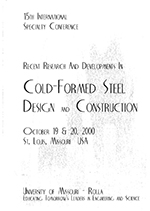Session Dates
19 Oct 2000
Abstract
A comprehensive experimental study was conducted to examine the shear and tensile strength of pneumatically driven pin connections used in cold-formed steel construction. This study included the key parameters that influence the connection strength: steel thickness (16-, 18- and 20-gauge steel), sheathing thickness (1/2" Unipan and 1/2" Dens-Glass Gold). The shear design values given in the AlSI design specifications for screw connections are compared with those obtained from a series of lap shear tests and a good agreement is obtained. Initial analysis of the AlSI design equation for tensile failure due to pull-over yielded poor results when compared to the withdrawal test values. Upon further analysis it was determined the connection failed in punch shear mode and the results compared well with the ACI punch shear analysis. The new equation developed in this study can be used to predict the strength of pneumatically driven pin connections in cold-formed steel construction.
Department(s)
Civil, Architectural and Environmental Engineering
Research Center/Lab(s)
Wei-Wen Yu Center for Cold-Formed Steel Structures
Meeting Name
15th International Specialty Conference on Cold-Formed Steel Structures
Publisher
University of Missouri--Rolla
Document Version
Final Version
Rights
© 2000 University of Missouri--Rolla, All rights reserved.
Document Type
Article - Conference proceedings
File Type
text
Language
English
Recommended Citation
Suaris, Wimal and Baur, Stuart Werner, "Evaluation of Cold-formed Steel Connections Attached with Pneumatically Driven Pins" (2000). CCFSS Proceedings of International Specialty Conference on Cold-Formed Steel Structures (1971 - 2018). 3.
https://scholarsmine.mst.edu/isccss/15iccfss/15iccfss-session10/3
Evaluation of Cold-formed Steel Connections Attached with Pneumatically Driven Pins
A comprehensive experimental study was conducted to examine the shear and tensile strength of pneumatically driven pin connections used in cold-formed steel construction. This study included the key parameters that influence the connection strength: steel thickness (16-, 18- and 20-gauge steel), sheathing thickness (1/2" Unipan and 1/2" Dens-Glass Gold). The shear design values given in the AlSI design specifications for screw connections are compared with those obtained from a series of lap shear tests and a good agreement is obtained. Initial analysis of the AlSI design equation for tensile failure due to pull-over yielded poor results when compared to the withdrawal test values. Upon further analysis it was determined the connection failed in punch shear mode and the results compared well with the ACI punch shear analysis. The new equation developed in this study can be used to predict the strength of pneumatically driven pin connections in cold-formed steel construction.



